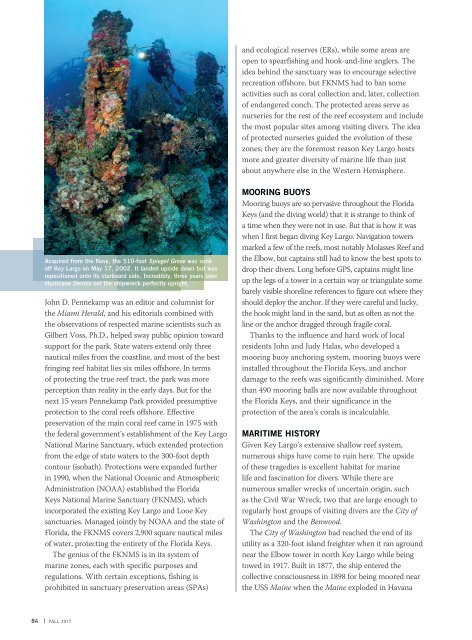AD 2017 Q4
Alert Diver is the dive industry’s leading publication. Featuring DAN’s core content of dive safety, research, education and medical information, each issue is a must-read reference, archived and shared by passionate scuba enthusiasts. In addition, Alert Diver showcases fascinating dive destinations and marine environmental topics through images from the world’s greatest underwater photographers and stories from the most experienced and eloquent dive journalists in the business.
Alert Diver is the dive industry’s leading publication. Featuring DAN’s core content of dive safety, research, education and medical information, each issue is a must-read reference, archived and shared by passionate scuba enthusiasts. In addition, Alert Diver showcases fascinating dive destinations and marine environmental topics through images from the world’s greatest underwater photographers and stories from the most experienced and eloquent dive journalists in the business.
Create successful ePaper yourself
Turn your PDF publications into a flip-book with our unique Google optimized e-Paper software.
and ecological reserves (ERs), while some areas are<br />
open to spearfishing and hook-and-line anglers. The<br />
idea behind the sanctuary was to encourage selective<br />
recreation offshore, but FKNMS had to ban some<br />
activities such as coral collection and, later, collection<br />
of endangered conch. The protected areas serve as<br />
nurseries for the rest of the reef ecosystem and include<br />
the most popular sites among visiting divers. The idea<br />
of protected nurseries guided the evolution of these<br />
zones; they are the foremost reason Key Largo hosts<br />
more and greater diversity of marine life than just<br />
about anywhere else in the Western Hemisphere.<br />
Acquired from the Navy, the 510-foot Spiegel Grove was sunk<br />
off Key Largo on May 17, 2002. It landed upside down but was<br />
repositioned onto its starboard side. Incredibly, three years later<br />
Hurricane Dennis set the shipwreck perfectly upright.<br />
John D. Pennekamp was an editor and columnist for<br />
the Miami Herald, and his editorials combined with<br />
the observations of respected marine scientists such as<br />
Gilbert Voss, Ph.D., helped sway public opinion toward<br />
support for the park. State waters extend only three<br />
nautical miles from the coastline, and most of the best<br />
fringing reef habitat lies six miles offshore. In terms<br />
of protecting the true reef tract, the park was more<br />
perception than reality in the early days. But for the<br />
next 15 years Pennekamp Park provided presumptive<br />
protection to the coral reefs offshore. Effective<br />
preservation of the main coral reef came in 1975 with<br />
the federal government’s establishment of the Key Largo<br />
National Marine Sanctuary, which extended protection<br />
from the edge of state waters to the 300-foot depth<br />
contour (isobath). Protections were expanded further<br />
in 1990, when the National Oceanic and Atmospheric<br />
Administration (NOAA) established the Florida<br />
Keys National Marine Sanctuary (FKNMS), which<br />
incorporated the existing Key Largo and Looe Key<br />
sanctuaries. Managed jointly by NOAA and the state of<br />
Florida, the FKNMS covers 2,900 square nautical miles<br />
of water, protecting the entirety of the Florida Keys.<br />
The genius of the FKNMS is in its system of<br />
marine zones, each with specific purposes and<br />
regulations. With certain exceptions, fishing is<br />
prohibited in sanctuary preservation areas (SPAs)<br />
MOORING BUOYS<br />
Mooring buoys are so pervasive throughout the Florida<br />
Keys (and the diving world) that it is strange to think of<br />
a time when they were not in use. But that is how it was<br />
when I first began diving Key Largo. Navigation towers<br />
marked a few of the reefs, most notably Molasses Reef and<br />
the Elbow, but captains still had to know the best spots to<br />
drop their divers. Long before GPS, captains might line<br />
up the legs of a tower in a certain way or triangulate some<br />
barely visible shoreline references to figure out where they<br />
should deploy the anchor. If they were careful and lucky,<br />
the hook might land in the sand, but as often as not the<br />
line or the anchor dragged through fragile coral.<br />
Thanks to the influence and hard work of local<br />
residents John and Judy Halas, who developed a<br />
mooring buoy anchoring system, mooring buoys were<br />
installed throughout the Florida Keys, and anchor<br />
damage to the reefs was significantly diminished. More<br />
than 490 mooring balls are now available throughout<br />
the Florida Keys, and their significance in the<br />
protection of the area’s corals is incalculable.<br />
MARITIME HISTORY<br />
Given Key Largo’s extensive shallow reef system,<br />
numerous ships have come to ruin here. The upside<br />
of these tragedies is excellent habitat for marine<br />
life and fascination for divers. While there are<br />
numerous smaller wrecks of uncertain origin, such<br />
as the Civil War Wreck, two that are large enough to<br />
regularly host groups of visiting divers are the City of<br />
Washington and the Benwood.<br />
The City of Washington had reached the end of its<br />
utility as a 320-foot island freighter when it ran aground<br />
near the Elbow tower in north Key Largo while being<br />
towed in 1917. Built in 1877, the ship entered the<br />
collective consciousness in 1898 for being moored near<br />
the USS Maine when the Maine exploded in Havana<br />
84 | FALL <strong>2017</strong>









